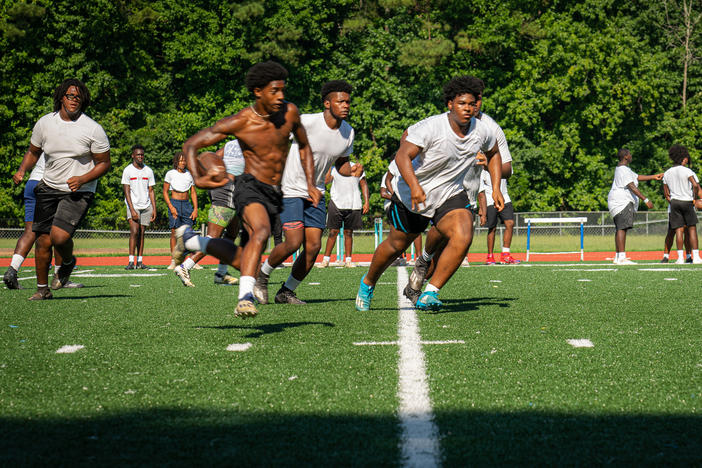Section Branding
Header Content
A new summer reality: hospitals and ERs see more patients with heat-related illness
Primary Content
With dangerously high temperatures across the country, hospitals are seeing more people with potentially deadly heat illness. A southern city is coping with what may be the new summer medical reality.
Transcript
AILSA CHANG, HOST:
With dangerously high temperatures all across the country, hospitals in the U.S. are seeing more patients with heat illness. Drew Hawkins of the Gulf States Newsroom explains how one Southern city is coping with a new medical reality.
(SOUNDBITE OF MACHINERY WHIRRING)
DREW HAWKINS, BYLINE: It's about 3 o'clock in the afternoon in New Orleans, but the streets are empty. The heat index is well over 100 degrees. Under the blazing sun, the pavement of the city's ambulance depot is scorching. EMS Captain Janick Lewis is showing me how they load stretchers into one of the newer ambulances.
JANICK LEWIS: Obviously, the nicest thing about being assigned to a brand-new unit is it's a brand-new air conditioning system.
HAWKINS: The newest ambulances come with a much more powerful AC, and Lewis says these days they really need it. Too much heat can lead to a condition called hyperthermia. That's when your core body temperature gets too high.
LEWIS: The No. 1 thing we can do to take care of somebody is get them out of the heat, get them somewhere cool. So the No. 1 thing we spend our time worrying about for the summertime is keeping the truck cool.
HAWKINS: Just last week New Orleans logged 29 emergency calls related to heat symptoms, more than three times the amount for the same period last year. Lieutenant Titus Carriere is also with New Orleans EMS, and he says people who live and work outside are especially at risk, like unhoused people.
TITUS CARRIERE: That's the first thing I honestly think of is hyperthermia because they've been often laying in tents in the extreme heat.
HAWKINS: Carriere says your body is normally really great at keeping itself cool. But if your internal temperature gets past 100, you start experiencing heat exhaustion. You'll have symptoms like weakness, dizziness and maybe a headache. Carriere says if you can get out of the heat and into some AC, generally you'll recover on your own. But if you don't, you could enter into the next stage - heat stroke.
CARRIERE: Once you move to heat stroke, your body stops compensating. You stop sweating. You're hot. You're dry, and your organs are basically, like, frying themselves from the inside out.
HAWKINS: If you can't sweat, it's even harder for your body to recover. Heat stroke can also cause confusion and rapid heartbeat. You may even lose consciousness. Carriere says EMS starts intervening as soon as they arrive on the scene.
CARRIERE: You will get them on a gurney, get them into the unit, start removing their clothing and put ice packs wherever applicable to try to cool them down.
HAWKINS: Once you're loaded into the ambulance, it's a race to the emergency room. You might end up at University Medical Center, the city's largest hospital, and be treated by Dr. Jeffrey Elder.
JEFFREY ELDER: So then when the patient ends up at the hospital, we're going to continue that cooling process.
HAWKINS: Elder is the emergency room director here. And he says getting your core temperature down as soon as possible is the highest priority, so they'll essentially bury you in ice. In other parts of the country, doctors actually put patients inside body bags packed with pounds of ice. Elder says they don't use body bags in his ER, but they do keep bags of ice ready to go.
ELDER: Typically, what we'll actually do is on the stretcher, we'll kind of use some of the sheets as kind of a barrier. And while they're on the stretcher, we'll just put the ice on them right then and there.
HAWKINS: They might even cover the patient with loose ice and point misting fans at the stretcher. Elder says his hospital has been treating more heat-related illness than ever before, and a few patients have died from the heat. And New Orleans isn't alone. Claudia Brown is a scientist with the National Center for Environmental Health at the CDC.
CLAUDIA BROWN: So extreme summer heat is increasing in the United States, and climate projections are indicating that extreme heat events will be more frequent and intense in the coming decades.
HAWKINS: With temperatures expected to continue to reach dangerous levels this summer and in the future, health infrastructure will need to keep up. For NPR News, I'm Drew Hawkins in New Orleans. Transcript provided by NPR, Copyright NPR.
Bottom Content



